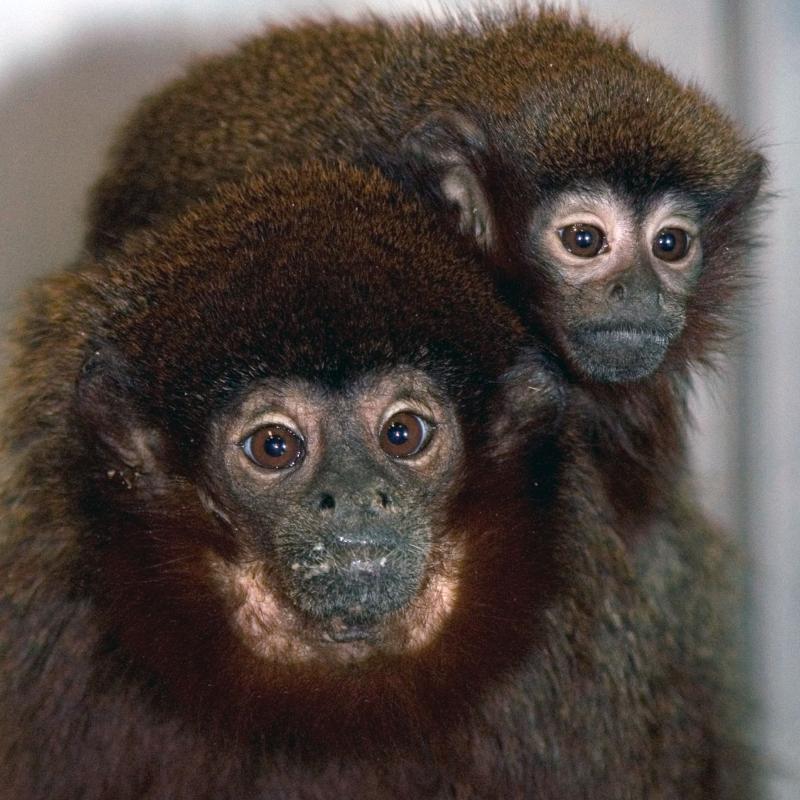Science News
New Virus, Not Horror Film

Last week a study in PLoS Pathogens reported that a new virus jumped from monkey to human in a lab at UC Davis. Around the same time, I eerily came across this post and Contagion movie trailer in Wired. Stories a bit similar, but actually all together different. They both have one thing in common—a viral outbreak that appears out of nowhere—but in one case it threatens a small population and the other, it threatens the world population.
The PLoS study does read a bit like a movie. A New World titi monkey fell ill with a cough in May 2009 at the California National Primate Research Center. Its condition worsened and the monkey was put down five days later. ScienceNOW reports that
Four weeks later, another titi monkey came down with the same symptoms. Then another. And another. Within 2 months, 23 of the 65-strong population had become sick, and 19 eventually died.
The center contacted UC colleague and virus researcher Charles Chiu, MD, PhD to help identify the pathogen and prevent its spread to other animals. (We interviewed Chiu, director of the viral diagnostics center at UC San Francisco, two years ago when the swine flu outbreak began.)
Examining tissues from the affected monkeys, Chiu and his team found that the virus clearly belonged to the adenovirus family, yet was unlike any adenovirus ever reported to infect humans or monkeys, including from large-scale studies by public health agencies. The new virus, named titi monkey adenovirus (TMAdV), is so unusual, in fact, that it shares only 56 percent of its DNA to its closest viral relative.
Adenoviruses naturally infect many animals, including humans, monkeys and rodents, and are known to cause a wide range of clinical illnesses in humans, from cold-like symptoms to diarrhea and pneumonia. Unlike influenza or coronaviruses, adenoviruses had not been known to spread from one species to another.
But Chiu noticed something in the lab about the new adenovirus, Nature News writes:
"It was unusual to see it grow well in human cell lines, but not monkey" cells, he says. This suggested that the virus could infect humans as well as titi monkeys. "After we interviewed all of the staff, the only person who said they had been sick was one researcher — the one who had had the closest daily contact with the colony," says Chiu.
That researcher experienced flu-like upper-respiratory-tract symptoms for four weeks. More crucially, a family member who had never visited the primate center also became ill — demonstrating that TMAdV can spread between humans.
Because the researcher's illness was minor, it was not reported for several months and the virus could no longer be detected directly. So Chiu worked with the California Department of Public Health to conduct antibody testing on the monkeys, the researcher and the family member. Both the monkeys and two humans tested positive for antibodies to the TMAdV virus. No other humans at the center were infected.
“Now adenoviruses can be added to the list of pathogens that have the ability to cross species,” says Chiu. “It's been hinted at before, but this study is the first to document these viruses crossing the species barrier in real time.”
Chiu says the lack of previous records of this virus in humans indicates that it is also unlikely to have started with the researcher. In testing other monkeys at the primate center, the team found one healthy rhesus (Old World) monkey with antibodies to TMAdV, which Chiu says could indicate that the virus originated in Old World monkeys, then spread to the New World colony that lacked antibodies against it.
The viral center is conducting further studies in both humans and monkeys in Brazil and Africa to determine whether the virus is common in wild populations of either Old World or New World monkeys, and whether it has crossed species in those settings to humans who live nearby.
It’s very important to note that the humans infected with the virus recovered fully without medical treatment. Contagion this story is not.
In fact, TMAdV may someday be beneficial to humans. From ScienceNOW:
TMAdV's rarity in humans could make it a potentially powerful tool as a viral vehicle for delivering gene therapy, Chiu adds. Researchers already use custom adenoviruses stitched with beneficial snippets of DNA to treat diseases; for instance, the cancer-fighting virus Gendicine introduces genes that code for the tumor-suppressing protein p53. The problem is that many people have antibodies to these viruses and their immune responses can make such treatments dangerous or even deadly. That problem likely wouldn't occur with an engineered version of TMAdV because nobody has antibodies to it. Chiu has a patent pending for using TMAdV as a gene-therapy vehicle.
Photograph courtesy of Kathy West